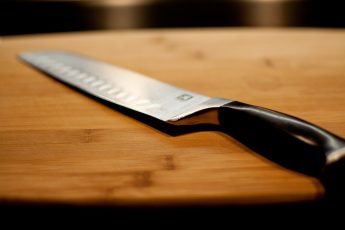Introduction
Quick Navigation
You are looking for the perfect knife that will dice, chop, mince, and slice your food in a clear and clean method. Any knife can do that. However, you want to find the ones that can do it effectively to do so without leaving any signs of struggle. Some blades are not ideal for chopping and slicing, as some are better for removing fish scales or removing flesh from bones and gristle. Some knives can slice well but can be too brittle to work with for extensive use, such as the ceramic knife. Therefore, you want to get a sturdy knife that can chop your food the way you want. The best knives for that are the chef’s knife as well as the Santoku. However, which knife is better to use in your kitchen for that purpose? Let’s go over the chef’s knife overview first, then the Santoku, and then compare them.
The Overview Of The Chef’s Knife
Most people who own knife sets have a chef’s knife, and they do not know about this knife’s specific function. However, it is excellent for chopping up any type of food: fruits, vegetables, meats, and the chef’s knife can cut through tough foods. The chef’s knife originated in France and Germany. The blade is a broad one, and the design features the curve of the edge that goes upward as the purpose is for the knife to form a tip. The tip allows the chef to thrust the blade in a forward position as they cut the food. It features a thick spine, and it can come in a serrated variety, as well as a Granton edge.
You can only find this knife is double bevel and feature a bolster. You can get a chef’s knife from six inches long to 12 inches long. However, most people have one that is eight inches long. However, professional chefs prefer a chef’s knife that measures from 10 to 12 inches. You should know about the chef’s knife that it is heavy to hold, making the chopping job strenuous if you work at it for a long time. However, it is a very sturdy knife that can last a long time. How is it different from the Santoku? Let’s find out.
The Overview Of The Santoku Knife
The Santoku has differences from the chef’s knife. Firstly, this knife originated in Japan, which you may figure based on this blade’s name. Therefore, it is not a European knife like the chef’s knife. Secondly, it features a wide blade that does not have a tip, unlike the chef’s knife. Instead, it has a sheepsfoot edge, which means that it has a dull back spine and makes a curve downward, connecting with the front blade. The Santoku knife is also slimmer than the chef’s knife, which allows it to slice food in thin slices or makes the cutting done in a refined way. The blade is the perfect fit for preparing foods part of the Japanese cuisine since thinly cut meats, vegetables, and fruits are part of it. Since the blade is thinner, it is light to hold and easier to balance, which is less likely to cause fatigue after long periods.
The Santoku knife can be single or double bevel, which makes this knife quite different from the chef’s knife. The single bevel knife allows you to make a smaller angle when sharpening it, making the blade extremely sharp. When it comes to thinly slicing foods, using a knife with that level of sharpness is necessary. Unlike the chef’s knife, it is rare for a Santoku knife to feature a bolster. However, it might have a Granton edge. The size can be anywhere from five inches long to seven and a half inches long. Therefore, as you can see, there are plenty of differences between the chef’s knife and the Santoku knife. Which one is better to use?
Is The Chef’s Knife Better Than The Santoku Knife, Or Vice Versa?
The answer to that question is: it depends. That all depends on what purpose you have to use the knife. Let’s talk about firstly the common uses for the Santoku knife. The term santoku means anything in three, as it has three benefits: mincing, chopping, and dicing. Therefore, the Santoku knife is excellent for thinly slicing meat, cheese, vegetables, and fruits. It is also known for mincing herbs or meat.
You can chop, dice, and slice nuts and seafood too with the Santoku knife, and it can work similarly to the ceramic knife in that way. However, the Santoku knife features a steel blade which makes it much sturdier than the ceramic blade. Those who have small hands can work well with this knife because of its straightforward design. What about the chef’s knife?
The chef’s knife may be heavier to hold than the Santoku knife; however, it is a lot more versatile. You can cut tougher meats and cut softer meats and other foods in complex ways that you cannot do with the Santoku knife. The only thing that it cannot do as well as the Santoku knife is to slice food thinly. However, aside from that, the chef’s knife is excellent for chopping, dicing, and cutting in larger pieces. If you have larger hands and regularly strengthen your muscles, you will not have difficulty working with the chef’s knife for long periods. That is because this blade is longer and heavier than the Santoku knife.
Conclusion
Every knife in your kitchen has its purpose, and that is why you have different uses for the chef’s knife and the Santoku knife, as neither one is better than the other. If you want to cut your food‘ into thin parts, you will need to use the Santoku knife. If you want a knife that can cut your food in more complex ways, then the chef’s knife is the better option for you. However, the one thing you need to know is that both blades require frequent sharpening and need care.
You need to learn to store these knives properly so they can last you a long time. You also want to invest in the best-quality chef’s and Santoku knives so they can provide high-quality results in your food preparation.

